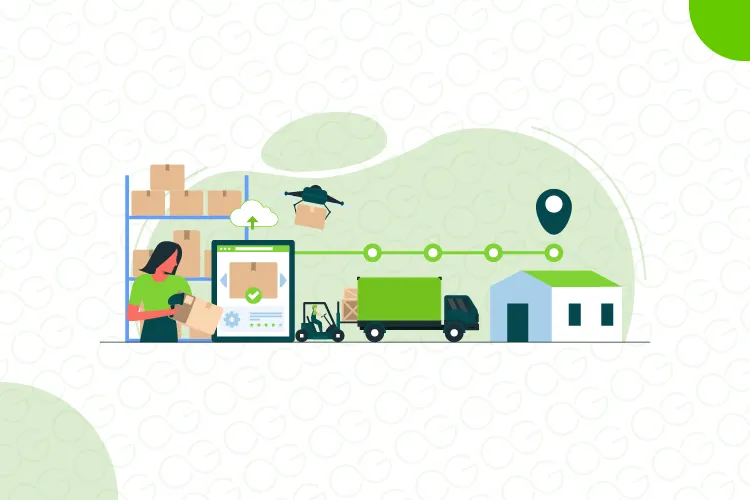The Strategic Importance of Distribution in Retail Business
Imagine having all your products in four or five separate locations. Now imagine trying to get a product from each of those distribution centers to one location. In the highly competitive retail sales business, getting the right goods, to the right stores, at the right time, and in the right amount is critical to the profitability of each store location and the entire chain.
In most retail stores, the amount of space available for receiving, checking, and displaying merchandise is limited. It is crucial that goods are efficiently moved to the selling floor in a timely manner by store personnel. For retailers to remain successful in an increasingly competitive market, they must maintain an uninterrupted merchandise flow on the sales floor.

Discover how Ginesys can help you manage multiple distribution centers efficiently.
Why Distribution Matters in Retail
Efficient distribution channels ensure that products are readily available to meet customer demand. Any disruption in this flow can lead to stockouts, customer dissatisfaction, and lost sales. On the other hand, overstocking due to inefficient distribution can increase storage costs and lead to wastage, especially in perishable goods.
One of the key functions of a distribution channel is to optimize your sales volume. While you might have several opportunities to distribute your product, limited production capacity means you need to identify the channels that generate the most sales and provide the highest ROI.
Distribution is not just about moving goods; it is about strategic planning and execution. Factors like demand forecasting, inventory management, and supply chain visibility are critical to achieving distribution excellence.
The Role of Technology in Modern Retail Distribution
In today’s retail landscape, technology plays a pivotal role in optimizing distribution processes. Advanced distribution management systems powered by technologies such as Artificial Intelligence (AI), Machine Learning (ML), and the Internet of Things (IoT) are transforming traditional supply chains into intelligent, data-driven ecosystems.
1. Real-Time Inventory Visibility
Technology enables real-time tracking of inventory across multiple locations. By leveraging IoT devices and RFID tags, retailers can monitor inventory levels, in-transit goods, and pipeline stock with precision.
2. Demand Forecasting with AI
AI-powered tools analyze historical sales data, seasonal trends, and external factors like market demand to provide accurate demand forecasts. This helps retailers optimize stock levels and avoid overstocking or understocking.
3. Automated Replenishment
Modern distribution systems use predictive analytics to automate stock replenishment. When inventory levels fall below a certain threshold, the system generates purchase orders and allocates stock from distribution centers to stores.
4. Route Optimization with Machine Learning
ML algorithms optimize delivery routes to ensure timely and cost-effective transportation. These systems consider factors like traffic, fuel costs, and delivery priorities to reduce transit time and expenses.

Ready to upgrade your distribution with AI-driven insights and real-time tracking? Ginesys makes it effortless.
How Ginesys Distribution Model Supports Retailers
The Ginesys distribution model is designed to address the unique challenges of retail distribution while leveraging modern technology to enhance efficiency. Here's how it benefits retailers:
1. Multi-Site, Multi-Option Integration
Ginesys provides seamless integration with internal and external POS systems, making it easy to manage distribution across multiple locations. Whether you operate a small chain of stores or a large retail network, Ginesys ensures that all sites are interconnected for smooth operations.
2. Pipeline Stock Tracking
With Ginesys, retailers can track pipeline stock across the supply chain, including allocated and in-transit inventory. This visibility ensures that retailers are always aware of stock movements and can plan accordingly to avoid stockouts or overstocking.
3. Shortage and Excess Tracking
Ginesys enables retailers to monitor and reconcile inventory discrepancies. By tracking shortages and excesses in real-time, retailers can address issues proactively, reducing waste and improving stock accuracy.
4. Transfer Reconciliation
Ginesys simplifies stock transfer reconciliation between locations. Retailers can ensure that all inventory movements are accounted for, minimizing errors and improving operational efficiency.
Advanced Ginesys Features for Distribution
To further support retail distribution, Ginesys includes several advanced features that leverage the latest technologies:
1. AI-Driven Demand Forecasting
Ginesys uses AI to analyze sales patterns, seasonal demand, and other factors to provide accurate demand forecasts. This ensures that stock levels are optimized, and retailers can avoid the costs associated with overstocking or stockouts.
2. Cloud-Based Distribution Management
The cloud-based design of Ginesys allows retailers to access their distribution data from anywhere, providing flexibility and scalability. Cloud technology ensures that all stakeholders have real-time access to critical information, enabling faster decision-making.
3. Integration with Third-Party Logistics (3PL)
Ginesys integrates with 3PL providers, enabling retailers to outsource their logistics operations while maintaining complete visibility and control over their supply chain. This integration streamlines the distribution process and reduces costs.
4. Omnichannel Distribution Support
Ginesys supports omnichannel distribution, ensuring that inventory is synchronized across online and offline channels. Retailers can fulfill orders from the nearest distribution center or store, reducing delivery times and enhancing customer satisfaction.

The Benefits of Efficient Distribution
An optimized distribution system offers numerous benefits for retailers, including:
1. Improved Customer Satisfaction
When products are available at the right time and place, customers are more likely to make purchases. Efficient distribution minimizes stockouts and ensures that customers find what they need, leading to higher satisfaction levels.
2. Cost Savings
By optimizing stock levels and transportation routes, retailers can reduce storage and logistics costs. Automation further minimizes manual errors, saving time and resources.
3. Faster Turnaround Times
Efficient distribution ensures that goods move quickly through the supply chain, reducing lead times and enabling retailers to respond swiftly to market demands.
4. Better Decision-Making
With real-time data and analytics, retailers can make informed decisions about inventory allocation, demand planning, and supply chain optimization.
Challenges in Retail Distribution
Despite its importance, retail distribution comes with its own set of challenges:
- Unpredictable Demand: Sudden changes in consumer preferences or external factors like pandemics can disrupt distribution plans.
- Supply Chain Disruptions: Delays in transportation, natural disasters, or supplier issues can impact distribution.
- Inventory Mismanagement: Without proper tracking systems, retailers risk overstocking or understocking.
- Rising Logistics Costs: Fuel price hikes, labor shortages, and other factors can increase transportation costs.
Future Trends in Retail Distribution
As technology continues to evolve, the future of retail distribution will be shaped by innovations such as:
1. Blockchain Technology
Blockchain can enhance transparency and traceability in the supply chain, reducing fraud and improving trust among stakeholders.
2. Robotics and Automation
Automated warehouses equipped with robots can speed up order picking, packing, and shipping processes.
3. Sustainability Initiatives
Retailers are increasingly adopting eco-friendly distribution practices, such as electric delivery vehicles and optimized packaging, to reduce their carbon footprint.
4. Hyperlocal Distribution
Hyperlocal distribution models focus on fulfilling orders from nearby stores or warehouses, ensuring faster deliveries and reducing logistics costs.

Future-proof your retail business with the powerful Ginesys distribution management system.
Distribution is the backbone of retail operations, ensuring that products reach customers efficiently and cost-effectively. In today’s fast-paced retail environment, leveraging technology is essential to optimize distribution processes and stay competitive.
Ginesys ERP offers a comprehensive distribution model that integrates advanced technologies like AI, cloud computing, and real-time tracking to streamline supply chain operations. By providing end-to-end visibility, predictive analytics, and seamless integration with logistics partners, Ginesys empowers retailers to overcome distribution challenges and drive profitability.
Investing in a robust distribution system like Ginesys is not just a strategic advantage—it is a necessity for retailers looking to thrive in a competitive market. Contact Ginesys today!

